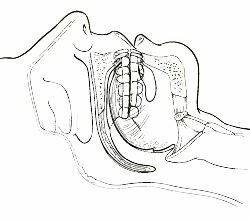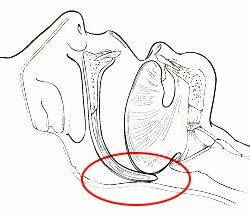Sleep apnea
Symptoms, causes and treatment options
Do you have the feeling that you don't sleep properly at night? Are you constantly tired during the day? Or do you snore regularly and your partner has already approached you about pauses in breathing during sleep?
Sleep apnea affects many people, but is often unrecognized. In this blog post, we explain what sleep apnea is, what symptoms can occur and how you can treat it.

Open airways

Closed airways
What is sleep apnea?
Sleep apnoea is a sleep disorder in which breathing pauses occur repeatedly during sleep. These pauses may only last a few seconds, but they disrupt the body's normal breathing and oxygen supply. Obstructive sleep apnoea (OSA) and obstructive sleep apnoea syndrome (OSAS) are particularly common.
Obstructive sleep apnoea (OSA): In this form, the upper airways close during sleep, leading to a blockage in breathing. This often happens due to sagging tissue in the throat, especially in older people or those who are overweight.
Obstructive sleep apnea syndrome (OSAS): This more severe form leads to more frequent and longer-lasting pauses in breathing and is often accompanied by severe daytime sleepiness. The constant interruption of sleep significantly impairs the quality of sleep, leading to problems such as difficulty concentrating and an increased tendency to fall asleep. These symptoms can even be dangerous, especially in road traffic, where so-called “microsleep” can lead to accidents.
Central sleep apnoea (CSA): This rarer form of sleep apnoea occurs when the brain does not send signals to the respiratory muscles during sleep, resulting in a complete cessation of breathing. It is usually caused by underlying conditions such as heart problems or neurological diseases.
The different forms of sleep apnea
| Habitual snoring | noise-producing vibration of the soft tissues caused by constriction and air turbulence in the upper airways. |
| OSA | Short pauses in breathing (apneas) during sleep for a duration of more than ten seconds and more frequently than 10 times per hour, with breathing movements present, caused by an obstruction of the upper airways, but no increased daytime sleepiness. |
| OSAS mild | Up to 20 apneas/hour and increased daytime sleepiness |
| OSAS moderate | 20-40 apneas/hour and increased daytime sleepiness |
| OSAS severe | over 40 apneas/hour and increased daytime sleepiness |
| ZSA | Pauses in breathing for more than ten seconds in the absence of respiratory movements, caused by various diseases, mostly of the heart (heart failure), sometimes also of the brain (stroke, circulatory disorders of the brain). |
| Undine Syndrom | Rare, congenital disorder of the central nervous system in which normal autonomic respiratory control is disturbed during sleep. |
Causes of sleep apnea
The most common cause of Obstructive sleep apnea (OSA) is the slackening of the tissue in the throat. This process is favored by various factors such as obesity, alcohol consumption or aging. The muscles in the throat relax, especially during sleep, and the airways can become blocked.
Obstructive sleep apnoea syndrome (OSAS) is more common in people with anatomically narrower airways. This can be due to genetic factors or physical conditions such as enlarged tonsils or a particularly narrow throat. Nicotine, alcohol and medication also contribute to the relaxation of the throat muscles and can exacerbate the symptoms.
Symptoms of sleep apnea
How do you recognize if you have sleep apnea? Symptoms can vary, but here are some common signs:
| Frequency | Possible symptoms |
| Very often | Constant fatigue during the day |
| Often | Repeatedly waking up at night gasping for air |
| Often | Poor memory |
| Often | Concentration problems |
| Possible | irritable, depressive, restless |
| Possible | Libido disorders, impotence |
| Possible | Frequent night-time urination |
| Possible | Dry mouth, drooling, grinding |
| Possible | Night sweats |
| Possible | Headache when waking up, gets better during the day |
How is sleep apnea treated?
The treatment of sleep apnea depends on the severity of the condition. There are various treatment options for obstructive sleep apnoea (OSA) and obstructive sleep apnoea syndrome (OSAS):
CPAP therapy (Continuous Positive Airway Pressure): The gold standard in the treatment of sleep apnea is the CPAP device. This device delivers air at a slightly positive pressure via a mask to keep the airways open and prevent breathing pauses. Adjusting the mask and air pressure requires some patience and sometimes several adjustment appointments. Some patients suffer side effects from CPAP ventilation, which can hardly be overcome even with the most careful adjustment.
Velumount method: If you suffer from mild to moderate forms of sleep apnoea and do not want to use the CPAP device or it is not effective enough, the Velumount method could be a good alternative. It consists of a special brace that mechanically keeps the throat open and prevents the airways from collapsing. This method has proven to be effective for many patients and is less expensive than the CPAP device.
Changes in lifestyle: Even simple changes can help with mild sleep apnea. Losing weight, abstaining from alcohol or changing your sleeping position can sometimes alleviate the symptoms.
For patients with central sleep apnoea (CSA), where the breathing problems are caused by a malfunction of the brain, treatment is often more complex. In such cases, a combination of different therapeutic approaches may be necessary.
When should you consult a doctor?
If you suspect you have sleep apnoea, it is important to see a specialist early on to get an accurate diagnosis. You should pay particular attention if you or your partner experience pauses in breathing during sleep. Symptoms such as severe daytime sleepiness and an increased tendency to fall asleep, which can have a significant impact on quality of life, are also an important indicator.
Treatment should not be delayed, especially if you suspect obstructive sleep apnea syndrome (OSAS), which also increases the risk of serious illnesses such as high blood pressure, heart attack and stroke. A visit to the doctor is particularly advisable if you suffer from the following symptoms:
Loud snoring and pauses in breathing during sleep
Daytime fatigue that does not go away even after a night's sleep
Difficulty concentrating and reduced performance
Irregular breathing during sleep that is noticed by your partner
Microsleep: If you repeatedly have the feeling of suddenly “falling asleep”, for example in traffic
Sleep apnea is more than just a minor inconvenience during sleep. It can pose serious health risks and severely affect your quality of life. If you notice symptoms such as snoring, pauses in breathing or constant tiredness, it is important to get them checked out early. There are numerous treatment options that can help you sleep better and feel refreshed and rested again.
Would you like to speak to a sleep specialist?
We offer a free consultation and are happy to discuss your next steps.

